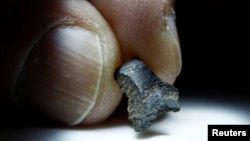The discovery of what is believed to be part of the world's oldest axe is giving scientists an insight into the innovation and adaptation of Stone Age settlers
in western Australia.
The thumbnail-sized fragment of basalt rock, polished smooth on one end, was discovered in the early 1990s at a rock shelter known as Carpenter's Gap in the northwest Kimberley region.
In 2014, the artifact was deduced to have come from an axe blade attached to a handle between 45,000 and 49,000 years ago, 10,000 years earlier than anywhere else in the world.
Professor Sue O'Connor of the Australian National University, whose team excavated the piece, believes its significance lies in the understanding that early Aboriginal settlements were not as elementary as first thought.
Professor Peter Hiscock of the University of Sydney, who led the analysis from 2014, agrees.
"The thing that is very clear is that as people have migrated out of Africa and adapted to all the different landscapes they've constantly had to invent new ways of making a living, new ways of engaging with each other. And so it's
creativity that is the common thread that underpins the success of humanity and colonizing the globe," he said.
Hiscock explained the ground edge of the tiny piece gave weight to the theory that the axe had a handle, as handles are typically found on ground edge specimens from this period.
Archaeologists believe that the fragment may have broken off the axe as it was being re-sharpened.
Hiscock dated the axe fragment using radio carbon analysis on a piece of charcoal buried at the same level in the earth at the archaeological site.
The findings were published this month in the Australian Archaeology journal.










